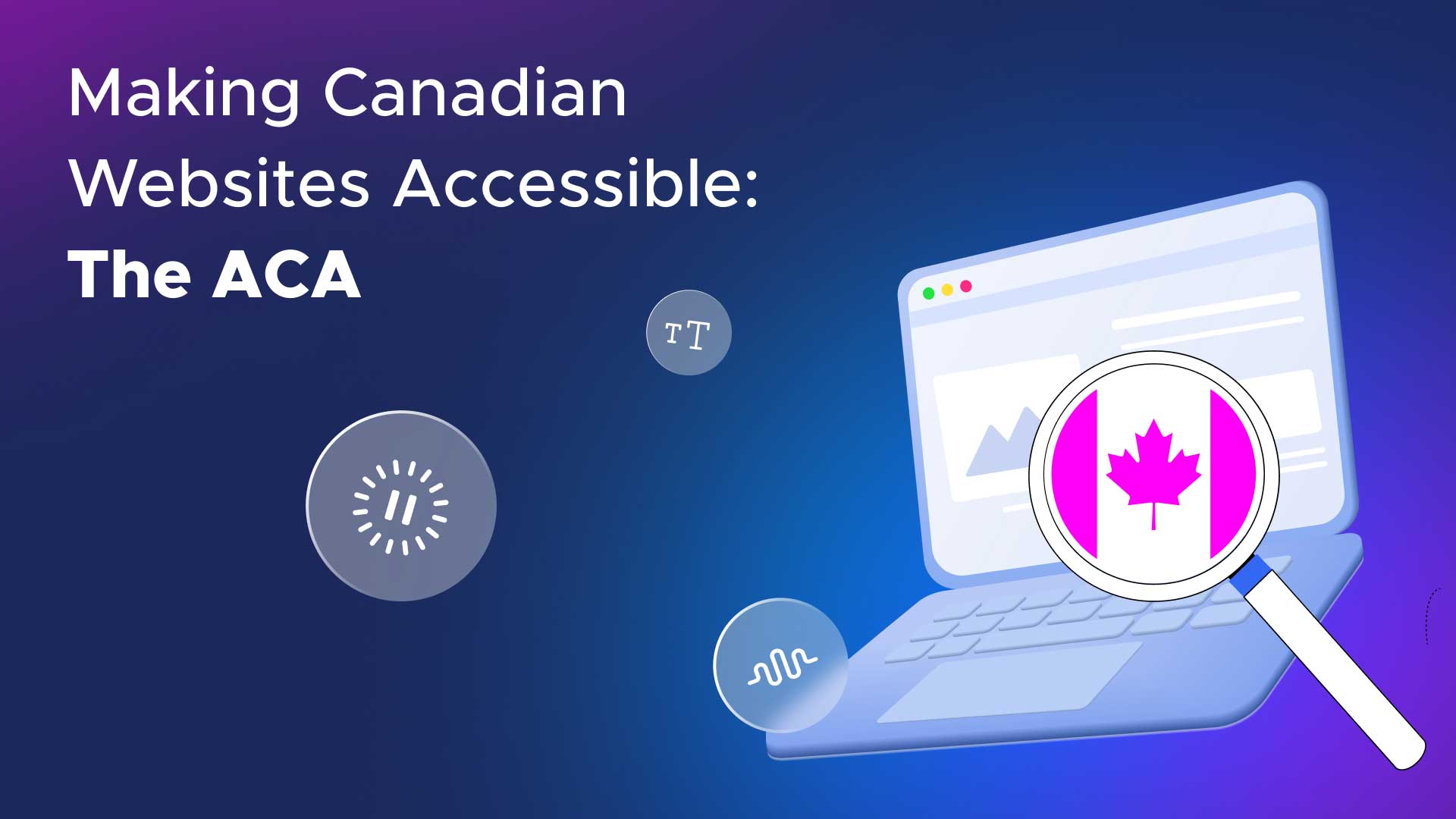Insights into Canada’s Web Accessibility Laws and Compliance

Canada was an early pioneer in the issue of disability inclusion and digital accessibility on the world stage well before it enacted the Accessible Canada Act (ACA). In Quebec, accessibility protections for public spaces were implemented as early as 1978. And the Canadian government issued an internet guide in 1998 which included tools and tips for web accessibility. In May 2000, it passed the Common Look and Feel (CLF) standards as its first website accessibility standards for all of its government agencies and was one of the early countries to require compliance with the Website Content Accessibility Guidelines (WCAG) 1.0. The Canadian government replaced its CLF standards in January 2010 with the Standard on Web Accessibility, the Standard on Web Usability, and the Standard on Web Interoperability. It also adopted WCAG 2.0 as the new standard. With the passage of the ACA, the government has signaled it intends to meet the needs of individuals with disabilities on a larger scale, meaning new regulations mandating compliance are likely on the horizon. Will your organization be ready? We will review Canada’s relevant accessibility laws and how they apply.
Accessible Canada Act (ACA)
In July 2019, the ACA came into effect and mandates to remove “anything that hinders the full and equal participation in society,” including Canadians’ ability to access information online. The legislation seeks to hasten a “barrier-free” Canada by January 1, 2040. ACA regulations apply to federally-regulated organizations, including employment, buildings, transportation, banking, the postal service, and radio and broadcast media. Standards and technical requirements are still being determined. However, WCAG 2.1 Level AA have been cited as a benchmark in some guidance measures, which is the most recent WCAG version currently available in French and English. It is anticipated many of these standards will become regulations and carry a penalty of up to $250,000 per violation.
Accessibility Standards Canada
The Accessibility Standards Canada organization was created under ACA legislation. The agency is tasked with creating technical committees, which will consist of a majority of individuals with disabilities and will identify and recommend standards. The organization held its second annual meeting in September 2022 and it is anticipated to roll out its first standards within the next year.
Canada’s Standard on Web Accessibility
The Standard on Web Accessibility was announced by Canada in January 2010, replacing its CLF standards adopted about a decade earlier. The Standard on Web Accessibility adopts the WCAG 2.0 guidelines to ensure that all Canadian government bodies remove and prevent accessibility barriers uniformly. In August 2010, Canada’s Web Experience Toolkit (WET) was released, providing free, open-source software giving public- and private-sector web developers access to “reusable components for building and maintaining innovative websites.” The toolkit’s resources are pre-built for compliance with the Standard on Web Accessibility and WCAG 2.0 Level AA.
Accessibility for Ontarians with Disabilities Act (AODA)
Passed in 2005 by the Legislative Assembly of Ontario, the Accessibility for Ontarians with Disabilities Act (AODA) requires businesses “to prevent and remove barriers for individuals with disabilities” for all public-facing organizations by 2025. The AODA established the Integrated Accessibility Standards Regulation (IASR) in 2011, requiring businesses with 50 or more employees and educational entities to make their websites, apps, and digital services accessible in accordance with WCAG 2.0 Level AA. Future updates will likely account for newer versions of WCAG. These regulations are laid out in the Information and Communications Standards. Under the AODA regulation and IASR, businesses are required to:
- Offer alternative formats for information and services, such as digital text, transcriptions, and large print.
- Provide accessible means for users to leave feedback.
- Ensure websites remain compliant with the WCAG.
Violations of the AODA can result in exorbitant monetary penalties based on the severity and history of the issues. Individuals, fiduciary officers, and unincorporated organizations can face fines of up to $50,000 daily if a violation persists. Corporations can be penalized up to $100,000 per day if they are found to be in violation.
Quebec’s Accessibility Laws
Accessibility laws to protect the rights of those with disabilities were in place in Quebec as early as 1978, making it the earliest province in the county to move on to this issue of human rights protections. The law was coined the “Act To Secure Handicapped Persons In The Exercise Of Their Rights with a View to Achieving Social, School, and Workplace Integration.” The act was overhauled in 2004, adding to the title “with a View to Achieving Social, School, and Workplace Integration.” It applies to public agencies, ministries, and municipalities. In 2006, Quebec adopted additional standards requiring agencies to adhere to digital accessibility standards for access to websites and online documents. Those standards included WCAG 1.0 criteria and were refreshed in 2012 to include WCAG 2.0.
Accessible British Columbia Act
The British Columbian government created the Accessible British Columbia Act in 2021 to make the province more inclusive for its citizens with disabilities. The act establishes accessibility standards for government agencies and will grow to regulate private organizations. According to British Columbia’s overview of the act, the intention is to include information and communication technology standards that will impact web content and websites. The act adopts WCAG 2.0 standards and establishes a fine and penalty framework as much as $250,000 for violations.
Accessibility for Manitobans Act (AMA)
The Accessibility for Manitobans Act (AMA) was passed in 2013 to prevent and remove barriers that can prevent equal access to resources and information for people with varying abilities. The Accessibility Standard for Information and Communication was adopted under the AMA in May 2022. The mandate applies to all organizations with one or more employees and focuses on making print and online resources barrier-free. Section 7 of the ICT makes WCAG 2.1 Level AA the required digital accessibility threshold. Manitoba government agencies have until May 2023 to adhere to the law. Public sector organizations, such as healthcare and education, must comply by May 2024. Non-profit and private businesses must be compliant by May 2025.
Nova Scotia Accessibility Act
The Nova Scotia Accessibility Act of 2017 established a framework for the province to be fully accessible by 2030, following the example of Quebec, Ontario, and Manitoba. The act will establish comprehensive standards for:
- Built environment
- Education
- Employment
- Information and communication
- Goods and services
- Transportation
Standards for built environments were the first guidelines to be addressed. The second phase of standard development was released in July 2022 as the accessibility act’s most recent milestone. The remaining standards are expected to be released at a rate of one per year. An independent review of the act launched in April 2022 and is anticipated to last 10 months. It will determine the direction for the future standards development process and possible changes to the legislation. It is anticipated websites will fall under the act’s Information and Communication standard. Government agencies are currently the only entities that fall under the act. Organizations and individuals who repeatedly fail to apply standards and violate the act are liable for fines of up to $250,000.
Evaluate Your Website For WCAG Compliance
The variety of Canada’s federal and provincial accessibility laws can appear confusing for those concerned with adhering to regulations. However, they all point to or are dependent on WCAG standards for digital accessibility, meaning organizations that adhere to the latest version of WCAG can protect themselves from civil liabilities and resulting penalties. UserWay’s Accessibility Scanner can help organizations determine how their websites matchup against WCAG web design protocols and provide recommended remediations for violations and issues. UserWay’s Accessibility Widget further helps web developers kickstart WCAG compliance by providing user-facing customizations to accommodate the most common accessibility limitations.
Frequently Asked Questions
Does Canada have its own version of the Americans with Disabilities Act (ADA)?
Yes, Canada’s national accessibility legislation is called the Accessible Canada Act (ACA) at the federal level, but several provinces also have their own accessibility laws. Provincial laws include the Ontarians with Disabilities Act (AODA) in Ontario, Quebec’s Act to Secure Handicapped Persons in the Exercise of their Rights with a View to Achieving Social, School, and Workplace Integration, Accessible British Columbia Act, The Accessibility for Manitobans Act (AMA), and Nova Scotia Accessibility Act.
Does Canadian law require my business to be web accessible?
Depending on where and how your business is operating, some Canadian accessibility laws may affect your business. Canada’s federal and provincial accessibility laws are being tightened and broadened every year. While most laws cover government agencies only, some provinces, such as Ontario and Manitoba, have extended requirements to the private sector. However, these laws rely on WCAG standards, meaning organizations that maintain robust WCAG compliance can avoid potential fines, penalties, and lawsuits.
Who enforces the Accessible Canada Act?
The Canadian Radio-television and Telecommunications Commission (CRTC) enforces the ACA. The CRTC regulates radio, television, phone, and internet, and handles all the accessibility complaints for these areas.
How do I make my website compliant with Canadian law?
Laws impacting web accessibility in Canada are built on WCAG standards. Organizations that bring their web and content pages into WCAG compliance can avoid violating accessibility laws. These standards are highly technical and can be difficult for non-developers to implement. Some organizations hire experts to build out their websites and remediate issues to reach WCAG compliance, but many others are looking for affordable, streamlined tools and services, such as UserWay’s AI-Powered Accessibility Solution and Managed Accessibility services.




Share